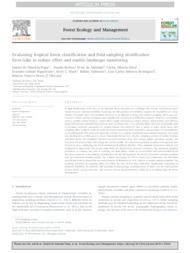Evaluating tropical forest classification and field sampling stratification from lidar to reduce effort and enable landscape monitoring.
Evaluating tropical forest classification and field sampling stratification from lidar to reduce effort and enable landscape monitoring.
Author(s): PAPA, D. de A.; ALMEIDA, D. R. A. de; SILVA, C. A.; FIGUEIREDO, E. O.; STARK, S. C.; VALBUENA, R.; RODRIGUEZ, L. C. E.; OLIVEIRA, M. V. N. d'
Summary: In high biodiversity areas, such as the Amazon, forest inventory is a challenge due to large variations in vegetation structure and inaccessibility. Capturing the full gradient of variability requires the acquisition of a large number of sample plots. Pre-stratified inventory is an efficient strategy that reduces sampling effort and cost. Low-cost remote sensing techniques may significantly expand pre-stratification capacity; however, the simplest option, satellite optical imagery, cannot detect small variations in primary forests. Alternatively, three-dimensional information obtained from airborne laser scanning (ALS, a.k.a. airborne lidar) has been successfully used to estimate structural parameters in tropical forests. Our objective was to assess to what extent forest plot sampling effort could be reduced, while accurately estimating mean vegetation characteristics in the landscape, by stratifying with ALS structural properties, relative to a random, uniformed conventional approach. The study was developed in an 800-ha area of wet Amazonian forest (Acre, Brazil), including portions of palms, bamboo and dense forest. We estimated relevant structural attributes from ALS: canopy height, openness, rugosity and fractions of leaf area index (LAI) along the vertical profile. We clustered vegetation to define heterogeneity into structural types, employing the Ward method and Euclidean distance. Also, principal component analysis was employed to characterize the groups using field and ALS-derived structural attributes. We simulated sampling intensities to estimate the gain in reducing the field efforts based on pre-stratified and non-stratified forest inventory scenarios. The resulting stratification clearly distinguished the forest?s structural variation gradient and the vegetation density profile. For a fixed uncertainty of 10% in basal area estimation, the ALS-aided stratified inventory reduced the necessary number of field plots by 41%, relative to simple random sampling. The resulting reduction in sampling effort can offset the cost of ALS data collection, significantly enhancing its financial feasibility. In addition, ALS provides broad-coverage quantifications of basal area (or aboveground carbon stock), canopy structure, and accurate terrain characterization, which have an added value for forest management.
Publication year: 2020
Types of publication: Journal article
Unit: Embrapa Acre
Keywords: Acre, Administração Florestal, Amazonia Occidental, Amazônia Ocidental, Amostragem, Amostragem de campo, Análise Estatística, Análisis de conglomerados, Análisis estadístico, Campo Experimental, Canopy gaps, Características de plantas, Cluster analysis, Cubierta forestal, Embrapa Acre, Espacios vacíos en el dosel, Estrutura Vegetal, Field forest inventory, Filed sampling, Floresta Tropical, Forest canopy, Forest management, Inventário Florestal, Leaf area index, Lidar, Manejo florestal, Plant characteristics, População de Planta, Raio Laser, Remote sensing, Rio Branco (AC), Sensoriamento Remoto, Statistical analysis, Tropical forests, Western Amazon, Índice de área foliar
Observation
Some of Embrapa's publications are published as ePub files. To read them, use or download one of the following free software options to your computer or mobile device. Android: Google Play Books; IOS: iBooks; Windows and Linux: Calibre.
Access other publications
Access the Agricultural Research Database (BDPA) to consult Embrapa's full library collection and records.
Visit Embrapa Bookstore to purchase books and other publications sold by Embrapa.

